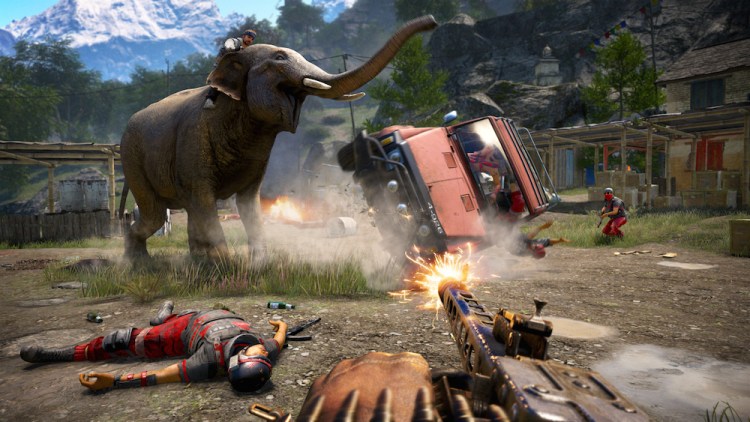Weapons and strategies of choice
For all the elements in moment-to-moment combat that are familiar to fans of Far Cry 3, the new features in Far Cry 4 succeed in adding freshness to otherwise familiar scenarios, particularly outpost infiltrations. Many of these mini bases can be cleared through classic stealth means, such as by throwing diversionary rocks or by charging in with your best weapons. Investing 20 minutes systematically eliminating guards without being detected is just as gratifying as conquering the same base with grenades, a rocket launcher, and your best submachine gun in less than three minutes.
And there’s no shame or deprived experience if you simply unlock an outpost’s elephant cage from 50 yards away with a grenade throw and let the animal take out the entire opposition for you. Compared to Far Cry 3, there are fewer ordinary bases with square-shaped layouts, which makes their takeovers all the more rewarding. Some only have one point of entry while others span multiple levels on the side of a hill.
Time equals rewards
Beyond satisfying obsessive compulsiveness in achieving 100 percent completion, letting yourself get sidetracked yields compounding rewards. Every action, whether it’s skinning animals or eliminating enemies with stealth, presents you with some award. It could be more experience points, which lead to skill points that go toward improving Ajay. Almost every action in Far Cry 4 is time well spent, unless you’ve been spending ten minutes on foot when you could have easily taken a truck or an ATV to your destination.
Speaking of vehicles, the methods of getting from point A to B have been positively expanded over the already impressive traversal conveniences of Far Cry 3. I thought that ziplines and hang gliders in the previous game were thrilling enough. Now you have single-person helicopters that are a blast to pilot but also provide the practical benefits of enabling you to survey the land below for nearby encampments and packs of animals you might be searching for.
Yet it’s the grappling mechanic that impressed me the most. Like an evolution over the simple climbing controls that appear whenever you approach ledges, grappling hooks enable you to scale lengthy cliff faces with swift efficiency. The moment I realized grappling also allowed for horizontal movement along walls was the moment Far Cry 4 carved its own sense of identity beyond just being “the sequel to Far Cry 3.” Add the Himalayan setting, tie-ins to Shangri-la, and the abundance of treasure waiting to be found, and you now have the closest thing to a first-person reimagining of Uncharted 2.
What you won’t like
Adapt or die
The Far Cry series, with its immensely open maps and unpredictable enemy AI behavior, has been revered as a refreshing alternative to the linear first-person shooters like the Call of Duty series. If you prefer the sense of control in picking off foes who are fixed behind the same cover point, you’ll seldom find that kind of predictability and ease in Far Cry 4. When you respawn in a Battlefield campaign, there’s comfort knowing that enemies will generally appear in the same area as before. Such assurances are rare in the Far Cry series, much thanks to the expansive spaces that provide opponents with a wealth of strategical options such as cover and flanking opportunities. Unless you thrive on thinking on your feet at all times, Call of Duty and Battlefield would be more your speed.
Conclusion
Far Cry 4 is the latest illustration that the best open worlds are those designed to function as playgrounds — where goals can be pursued even when impulsiveness thrives. While it received a good deal of help from a rock-solid foundation that is Far Cry 3, this sequel introduces more than enough new features that both games should be regarded as companion pieces to each other.
Far Cry 4 is the furthest thing from a mere upgrade. As developers struggle to decide how much a sequel should be similar or different from its predecessor, Ubisoft shows immense skill in finding a happy medium in Far Cry 4.
Score: 94/100
VentureBeat's mission is to be a digital town square for technical decision-makers to gain knowledge about transformative enterprise technology and transact. Learn More



